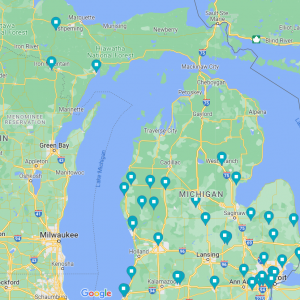Fresh, August 22, 2023: Wetter, Hotter Minnesota Summers Jeopardize Sacred Manoomin
August 22, 2023
Fresh is a biweekly newsletter from Circle of Blue that unpacks the biggest international, state, and local policy news stories facing the Great Lakes region today. Sign up for Fresh: A Great Lakes Policy Briefing, straight to your inbox, every other Tuesday.
— Christian Thorsberg, Interim Fresh Editor
This Week’s Watersheds
- Copi, formerly known as Asian carp, a non-native fish found for decades in Lake Michigan, is becoming a favorite menu item in Illinois.
- A new retention basin in Montreal will greatly reduce sewage releases into the Lachine Canal during summer floods.
- Greater rainfall in northern Minnesota is making the harvest of manoomin (sacred wild rice) more difficult for Ojibwe communities who depend on the crop.
- Two years after “toxic” test results, a former military base on the shores of Lake Huron will receive groundwater treatment systems.
Residents of Chicago’s South Shore neighborhood have seen their Lake Michigan shoreline erode hundreds of feet — a consequence of climate change they continue to prepare for.
“South Shore is uniquely vulnerable. It’s had a lot of impacts over the last century, plus, certain sections of it have even been washed out.” — Malcolm Mossman, a project lead at the Delta Institute, a nonprofit focusing on environmental issues in the Midwest.
Erosion on the banks of Lake Michigan has been particularly acute in Chicago’s South Shore neighborhood in recent years, backing up residents’ backyards, creating sinkholes, eliminating beaches, and flooding apartments, Grist reports.
“What was once a tedious but manageable issue is now a crisis,” writes Grist’s Siri Chilukuri. And residents are taking action — demanding, for starters, that the city approve a $5 million plan to “hold back the water.”
The community-led South Side Lakefront Erosion Task Force seeks to hold the city and other leaders accountable in ensuring that their portion of the lakefront is protected, funded, and held in equal consideration with other city beaches.
Fresh from the Great Lakes News Collaborative
- Scientists are learning just how complicated it will be to reduce toxic blooms in Lake Erie — Michigan Radio
- Consumers’ decision on 13 dams could alter Michigan rivers, towns — Bridge Michigan
- Mapping the Great Lakes: Who is looking out for the Great Lakes? — Great Lakes Now
The Great Lakes News Collaborative includes Bridge Michigan; Circle of Blue; Great Lakes Now at Detroit Public Television; and Michigan Radio, Michigan’s NPR News Leader. We work together to produce news and information about the impact of climate change, pollution, and aging infrastructure on the Great Lakes and drinking water. This independent journalism is supported by the Charles Stewart Mott Foundation. Find all the work here.
Hot, Wet Summers Threaten Sacred Manoomin
In the 1930s, construction of the Buck More Dam was completed in northern Minnesota, bringing the water levels of Ogechie Lake to more than four feet high — “too high for manoomin,” what the Ojibwe call wild rice, Sahan Journal reports. As a result, “for more than 70 years there was virtually no rice, and very little waterfowl and wildlife” on the lake, which is “part of the Mille Lacs Band of Ojibwe Reservation and Minnesota’s Kathio State Park.”
In 2015, a successful partnership between the tribe and the state helped reverse this impact: The dam was modified to reduce Ogechie’s water levels. Today, wild rice again grows plentifully, and migratory bird species call the habitat home. Per Sahan, more wild rice grows in Minnesota than in any other U.S. state.
But this happy ending is being upended by shifts in northern Minnesota’s precipitation. According to Minnesota’s Department of Natural Resources, ten of the state’s hottest and wettest years have occurred within the past quarter-century.
From 1895 through 2022, the Rum River watershed “received an average of 28 inches of rain…But for the past 20 years, annual precipitation in the watershed has risen to an average of around 31 inches.” In other words, to increase the average so dramatically, the last two decades have been significantly wetter than the entire century previous.
This extra water has contributed to flooding that has wiped out entire wild rice harvests during all parts of the growing season. In the spring, rice has been swept away before having the chance to grow. In the fall, strong floodwaters have separated nearly full-grown rice from their stalks.
Despite the heat and flooding that has ravaged the Midwest this summer, as well as the persisting existential threat of climate change to the sacred crop, the 2023 wild rice harvest on Lake Ochegie is better than expected. Sahan reports that 70 percent of the lake is covered with manoomin.
“It goes so far beyond restoring wild rice,” Todd Moilanen, the cultural resources director of the Mille Lacs Band of Ojibwe, told Sahan. “It’s a whole lifecycle, a whole world is restored.”
In Context: Minnesota Tribe Sets Enforceable Rules To Safeguard Wild Rice and Water Supply
In the News
Lachine Canal: Around five times per summer — and most recently in mid-July — heavy rainfall prompts authorities in Montreal to release excess sewage into the Lachine Canal, which flows into the St. Lawrence River. The sewage releases close the river to swimmers and boaters. Now, a new $45 million underground water retention basin will improve the city’s drainage capacities, the Montreal Gazette reports. The concrete reservoir can take in 15 Olympic-sized swimming pools’ worth of water in just 45 minutes.
Oscoda, Michigan: Two years ago, six military sites throughout the Great Lakes region were found to have toxic levels of PFAS in their groundwater, AP reports. Now, two testing systems will be installed beneath one of those sites: the former Wurtsmith Air Force Base in Oscoda, Michigan, which closed in 1993. Officials are hopeful that the installations will not only clean the current contaminated water, but prevent the further spread of PFAS into the community and “adjacent waters,” which includes Lake Huron, whose shores are just one mile away.
In context: Fear and Fury in Michigan Town Where Air Force Contaminated Water
Looking Ahead
Copi Delicacies: In June 2022, Asian carp — a non-native fish found in Lake Michigan and other Midwest waterways, to the detriment of local species — was officially renamed “copi” by the state of Illinois and the U.S. Food and Drug Administration. It was an effort to promote the fish as an attractive source of food for harvesters and consumers. At this past week’s Illinois state fair, the Chicago Sun-Times reports, the effort has begun to pay dividends. A myriad of copi recipes made their debut, proving popular amongst fair-goers and landing as likely permanent menu items for some vendors.
Upcoming Events
August 20-24 — American Fisheries Society 153rd Annual Meeting — learn more and register
September 6-7 — Great Lakes Dredging Team Meeting — learn more
September 8-9 — Great Lakes-St. Lawrence Legislative Caucus Annual Meeting — learn more
Other News
Jefferson Chalmers: The ‘Venice of Detroit,’ a neighborhood “oriented around a canal system and waterfront parks,” is being adversely affected by both flooding and worries that “climate gentrification” could price lifelong residents out of the community, Planet Detroit reports.
Lake Ontario: Environmental officials are assessing how much runoff has potentially spilled into Lake Ontario following an industrial fire in Toronto, CBC News reports.
Christian Thorsberg is an environmental writer from Chicago. He is passionate about climate and cultural phenomena that often appear slow or invisible, and he examines these themes in his journalism, poetry, and fiction.









Leave a Reply
Want to join the discussion?Feel free to contribute!